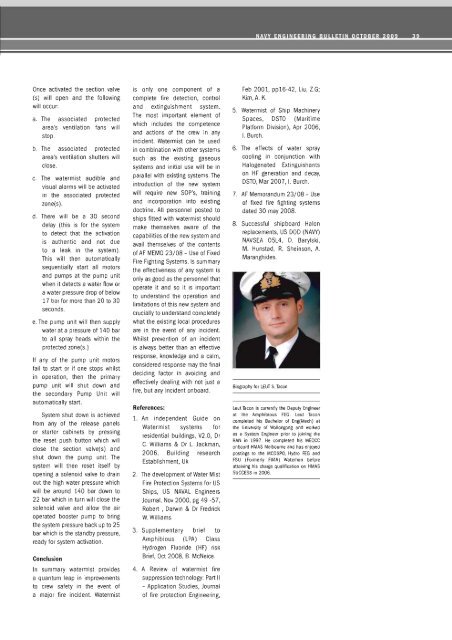ENGINE - Royal Australian Navy
ENGINE - Royal Australian Navy
ENGINE - Royal Australian Navy
Create successful ePaper yourself
Turn your PDF publications into a flip-book with our unique Google optimized e-Paper software.
Once activated the section valve<br />
(s) will open and the following<br />
will occur:<br />
a. The associated protected<br />
area's ventilation fans will<br />
stop.<br />
b. The associated protected<br />
area's ventilation shutters will<br />
close.<br />
c. The watermist audible and<br />
visua l alarms will be activated<br />
in the associated protected<br />
zone(s).<br />
d. There will be a 30 second<br />
delay (this is for the system<br />
to detect that the activation<br />
is authentic and not due<br />
to a leak in the system).<br />
This wi ll then automatically<br />
sequentially start al l motors<br />
and pumps at the pump unit<br />
when it detects a water flow or<br />
a water pressure drop of below<br />
17 bar for more than 20 to 30<br />
seconds.<br />
e. The pump unit will then supply<br />
water at a pressure of 140 bar<br />
to all spray heads within the<br />
protected zone(s.)<br />
If any of the pump unit motors<br />
fail to start or if one stops whilst<br />
in operation, then the primary<br />
pump unit will shut down and<br />
the secondary Pump Unit will<br />
automatically start.<br />
System shut down is achieved<br />
from any of the release panels<br />
or starter cabinets by pressing<br />
the reset push button which will<br />
close the section valve(s) and<br />
shut down the pump unit. The<br />
system will then reset itself by<br />
opening a solenoid valve to drain<br />
out the high water pressure which<br />
will be around 140 bar down to<br />
22 bar which in turn wi ll close the<br />
solenoid valve and al low the air<br />
operated booster pump to bring<br />
the system pressure back up to 25<br />
bar which is the standby pressure,<br />
ready for system activation.<br />
Conclusion<br />
In summary watermist provides<br />
a quantum leap in improvements<br />
to crew safety in the event of<br />
a major fire incident. Watermist<br />
is on ly one component of a<br />
complete fire detection, control<br />
and extinguishment system.<br />
The most important element of<br />
wh ich includes the competence<br />
and actions of the crew in any<br />
incident. Watermist can be used<br />
in combination wi th other systems<br />
such as the existing gaseous<br />
systems and initial use will be in<br />
parallel with existing systems. The<br />
introduction of the new system<br />
will require new SOP's, training<br />
and incorporation into existing<br />
doctrine. All personnel posted to<br />
ships fitted with watermist should<br />
make themselves aware of the<br />
capabilities of the new system and<br />
avail them selves of the contents<br />
of AF MEMO 23/08 - Use of Fixed<br />
Fire Fighting Systems. Is summary<br />
the effectiveness of any system is<br />
only as good as the personnel that<br />
operate it and so it is important<br />
to understand the operation and<br />
limitations of th is new system and<br />
crucially to understand completely<br />
what the existing local procedures<br />
are in the event of any incident.<br />
Whilst prevention of an incident<br />
is always better than an effective<br />
response, knowledge and a calm,<br />
considered response may the final<br />
deciding factor in avoiding and<br />
effectively dealing with not just a<br />
fire, but any incident onboard.<br />
References:<br />
1. An independent Guide on<br />
Watermist systems for<br />
residential buildings, V2.0, Dr<br />
C. Wil liams & Dr L. Jackman,<br />
2006, Building research<br />
Establishment, Uk<br />
2. The development of Water Mist<br />
Fire Protection Systems for US<br />
Ships, US NAVAL Engineers<br />
Journal, Nov 2000, pg 49 -57,<br />
Robert , Darwin & Dr Fredrick<br />
W. Williams.<br />
3. Supplementary brief to<br />
Amphibious (LPA) Class<br />
Hydrogen Fluoride (HF) risk<br />
Brief, Oct 2008, B. McNeice.<br />
4. A Review of waterm ist fire<br />
suppression technology: Part II<br />
- Application Studies, Journa l<br />
of fire protection Engineering,<br />
Feb 2001, pp16-42, Uu , Z.G;<br />
Kim,A. K.<br />
5. Watermist of Ship Machinery<br />
Spaces, DSTO (Maritime<br />
Platform Division), Apr 2006,<br />
I. Burch .<br />
6. The effects of water spray<br />
cooling in conjunction with<br />
Halogenated Extingu ishants<br />
on HF generation and decay,<br />
DSTO, Mar 2007, I. Burch.<br />
7. AF Memorandum 23/08 - Use<br />
of fixed fire fighting systems<br />
dated 30 may 2008.<br />
8. Successful shipboard Halon<br />
replacements, US DOD (NAVY)<br />
NAVSEA 05L4, D. Barylski,<br />
M. Hunstad, R. Sheinson, A.<br />
Maranghides.<br />
Biography for LEUT S. Tacon<br />
Leut Tacon is currently the Deputy Engineer<br />
at the Amphibious FEG. Leut Tacon<br />
completed his Bachelor of Eng(Mech) at<br />
the University of Wollongong and worked<br />
as a System Engineer prior to joining the<br />
RAN in 1997. He completed his MEOCC<br />
onboard HMAS Melbourne and has enjoyed<br />
postings to the MCDSPO, Hydro FEG and<br />
FSU (Formerly FIMA) Waterhen before<br />
attaining his charge qualification on HMAS<br />
SUCCESS in 2006.

















